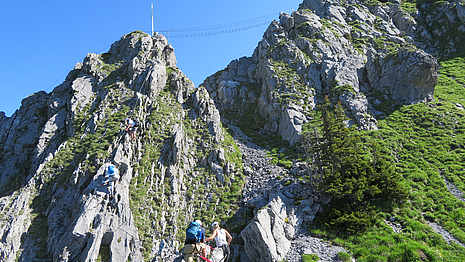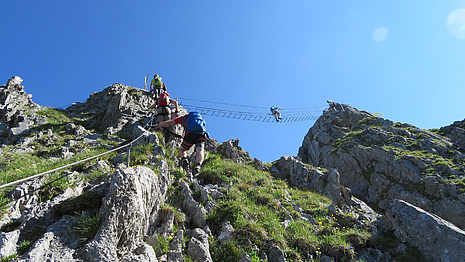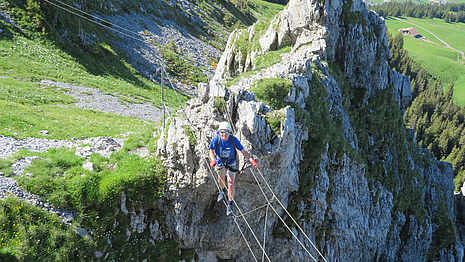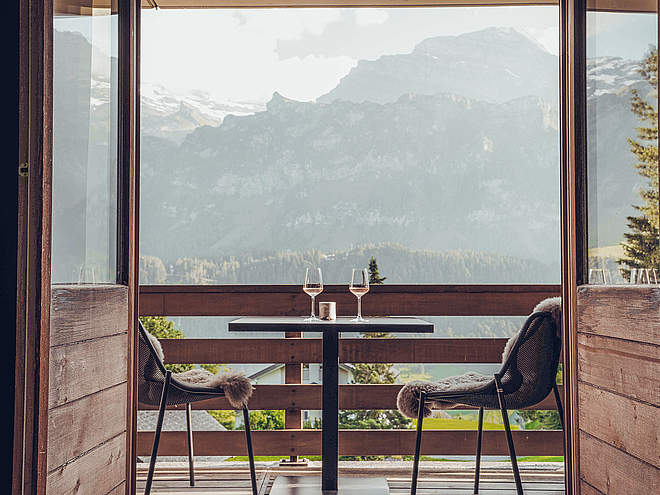Even on the Brunnistöckli via ferrata, the view does not extend far. You can see from step to step and from hold to hold. But the view down into the valley is denied. The panorama, which others appreciate, is not missed by all via ferrata climbers.
"Maybe it's not so bad that I can't see very far," quips a participant who is still trying to come to terms with the altitude. Eight people are travelling with a mountain guide. They all benefit from the three-day course offer "Rock & Safety Days", which Engelberg-Titlis Tourism offers free of charge to holders of a guest card. With the support of experienced mountain guides and with the help of mental training, the participants are made fit for the via ferratas.
"The aim of the "Rock & Safety Days" is the professional training of via ferrata walkers. After the three days, they should be able to master such via ferratas independently. This also includes assessing risks and their own abilities as well as being focused and having fun," says Daniel Perret, mountain guide at Prime Mountain Sports GmbH, summing up the offer.
27-year-old Simone Hug from Hinwil has already completed several via ferratas - but always in the company of experienced colleagues. Because she wanted to climb the steps and holds on her own, she spontaneously signed up for the "Rock & Safety Days". Kurt Hägi is also on the course. At 66, he is the oldest participant. "I'm often in Engelberg and, apart from the Fürenwand, I've already done all the via ferratas," he says. "I always just marvelled at the Fürenwand. But I didn't dare to climb it." Like all the other participants, a mixed group of beginners and advanced climbers, he is pursuing the goal of tackling the steep, exposed classic on the third day of the course. Because the Fürenwand with its 765 metres of height difference, the difficulty level K4 - K5 (K1 = easy, K6 = extremely difficult) and the finish Fürenalp makes an impression and is truly not everyone's cup of tea.
But the three-day course starts leisurely - with the Brunnistöckli, excellent with the difficulty level K2 and the constant possibility of breaking off. "Thanks to its moderate difficulty, the airy bridges and a summit experience, the Brunnistöckli is ideally suited for an introduction to the via ferrata world," says mountain guide Daniel Perret. "Here, as a mountain guide, you immediately see who moves in the terrain and how, and where the participant's strengths and weaknesses lie." Despite wet weather, all eight make it to the Brunnistöckli. Some fared a little better, others had a little more trouble with the altitude.
Day two takes the mixed group of men and women between the ages of 20 and 66 to Rigidalstock.
This medium-difficulty climb (K4) without exit options, but exposed, pushes three of the participants to their limits to such an extent that they decide to forego the Fürenwand highlight. "Retreating or breaking off in the middle of the Fürenwand is problematic and only possible under difficult conditions," Daniel Perret explains the reason why insecure participants should rather leave this climb. The three participants mentioned above voluntarily gave up. "Almost always, the guests notice it themselves because they are afraid of the altitude or have physical difficulties." But if the mountain guide sees that someone is technically and mentally ready for the wall, he naturally tries to motivate that person.
For the five remaining climbers, the second day concludes with mental training with Claudia Müller. She teaches future ski cracks at the sports middle school in Engelberg and supports them in the mental area. "You can look forward to tomorrow," she says, "the view of Engelberg is sensational." But of course, her work is not done with just this "treat". She prepares the five course participants for the Fürenwand with various impressive exercises. In the exercises it quickly becomes clear what an important role the head plays - be it in climbing or in everyday life.
If you have doubts when you enter the wall, you won't get far. And for Claudia Müller it is very important: "Mental training is not a magic cure. It is a training that has to be applied again and again." Her words, the exercises and the visualisation of the Fürenwand seem to have had an effect. "After the mental training, I spent a quiet night. I gained the certainty that it would work the next day," says Kurt Hägi. And his positive feeling was not to deceive him: On the final day, together with his four colleagues, he mastered the Fürenwand in beautiful weather. At the behest of the mountain guide, Kurt Hägi, the most experienced man in the group, climbs the wall first. "The respect was still there, but with every metre of height I felt more confident - and that despite the fact that the distance to the valley floor was increasing." Only the end with the vertically mounted exit ladder initially gave him a bit of trouble. Take a deep breath and think of Claudia Müller's words "you can do it" - take it step by step - you did it! "Wonderful feelings came up," Hägi remembers fondly of his first and certainly not last ascent of the Fürenwand.
Simone Hug was also on her way with a good feeling, as she was looking forward to the final highlight of the course. "During the ascent, I always felt comfortable. On the one hand, I had complete trust in the mountain guide, and on the other hand, I felt capable of climbing the wall." Her summit experience was also an unforgettable one. But she remembers the "Rock & Safety Days" just as well - so well, "that just four days after the course I tackled the first via ferrata on my own". Goal of the course achieved.








































